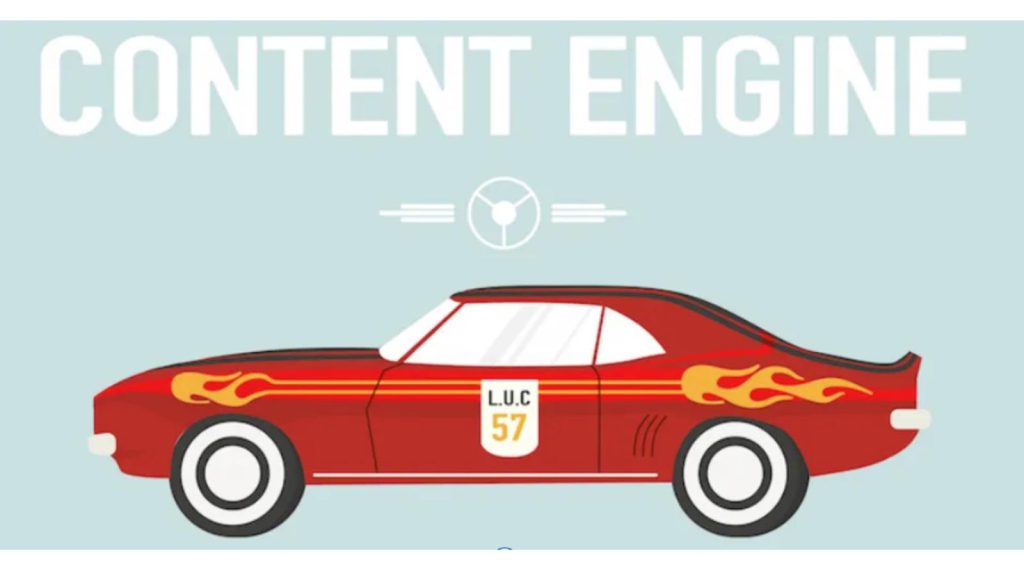What is a Content Marketing Engine? It is the processes, tools, and people that deliver consistent, targeted, high-quality content in a variety of media formats.
Content marketing for search engines helps your content be found when people are searching online for answers.
A content engine can include blog content, eBooks, webinars, infographics, videos, slide shares, and slide sets.
Content Marketing, done well, fuels your digital hub by building a “content engine” to drive people to your business. Keeping your engine tuned up with a rich mix of content types helps to keep things running smoothly.
Smoothly enough that people want to come back more than once to visit your digital offerings.
Table of Contents
Unique Content For Your Marketing
As a critical component of your company’s marketing strategy, Content Marketing consists of unique content aligned closely to the specific audience you serve.
Evaluate the kinds of content you want to provide as digital resources for your content marketing engine. But, mixing content styles lets you appeal to different people in different ways.

Everything from webinars to eBooks to audio content to white papers and everything in between is a form of quality blog content. Think about the best way to deliver a meaningful message.
Creating Content
Creating content assets to connect with people while building brand recognition and credibility is the goal. But, it’s not always easy to put an effective content engine into motion, let alone to keep it chugging along.
Better yet, speeding along, gaining business momentum as you go building your content marketing engine.
This post (and infographic) gives you 10 essential elements to oil up and keep your content marketing engine in tip-top shape.
By following these tune-up items, you can develop, manage, and grow your content resources for positive results. Of course, they are many content marketing tools to help you achieve this too.
What Your Content Engine Runs On
Your content engine runs on people, processes, and tools. And, it’s designed to deliver high-quality, targeted, and consistent content to connect your business with people.
Click On Your Seat Belt Now For Those 10 Elements:
Without executive or management buy-in, your content engine may stall or at least only sputter. Worse, operating without C-level support is like trying to hop on a racetrack with no spark plugs.
Simply put, you need (HINT: Present your case so executives are shaking their heads, “yes.”)
Your content has two jobs. The first has to do with understanding and relating to your target audience. The other is to incorporate the broader business and marketing strategy of the company.
Intersect these two objectives and your content engine will be running on high octane in the fast lane.
Develop a content hub, typically via your digital home—your website and blog. Your goal is to create a resource-filled experience for visitors and customers.
Because without a quality hub to engage people, there’s no point taking the next steps with SEO, social media marketing and promotions, or advertising.
Hang On For More Content Marketing Engine Magic
Content creators are the magicians for a compelling content hub. Their techniques are not just wishful mechanics, though.
Rather, a mix of research, excellent writing, editing skills, and visualization are only some of the many pieces to craft quality output.
Designers and technicians also have a vital role in producing more complex works and in using various mixes of media. The possibilities are endless for presenting a well-rounded content engine mixture to make it purr.
Visuals add impact and are powerful for conveying information concisely. Event photography can enhance this by capturing high-quality images that effectively communicate your message.
Tools to factor SEO into your content, automate social sharing and promotion, and advertising, speed up your traffic-building by helping you find a wider reach.
Plus, using email marketing automation gives you a chance to talk directly to your audience, based on their needs, in a way that’s helpful.
Management and Calendars
Asset management includes establishing workflows and processes and collaborating with project management tools. Finally, setting up timelines as well as approval flows for content pieces.
Therefore, an Editorial Calendar helps you to hone in on content topics. It also guarantees a media mix and set targets. This stays consistent in planning and executing your content schedule.
You may want to include seasonal and holiday content possibilities and ideas in your calendar. Then, you can set up a guideline for content types to use that your audience will love.
Also, you may want to make a version of an Editorial Calendar to set your social media promotions schedule.
Infuse Your Personality Into Your Content Marketing
Next, don’t forget a very important content component by infusing your brand personality into content production. Remember, your content is a way for people to get to know you.
Create guidelines to present a clear, consistent “voice” for your business by coordinating the style and attitude of digital assets.
Everything from fonts to color schemes to grammar guides comes into play here. And once again, consistency revs up your recognition and clarifies what you are communicating.
Analytics For Measuring
Analytics is important to understand what works and what doesn’t in your content engine. Sure, you can just keep running your motor, but running at optimal performance means you need to know how to improve.
Without measuring and tracking your content, you have no way of understanding what is resonating with viewers. Time on the page, for example, helps you know if people are engaging rather than just stopping by.
For your content engine, the longer time visitors spend cruising through your content and hub resources, means a winning motor.
That’s why content marketing for search engines is key today to being found online when people are searching for answers like where to buy or rent a property.
Framework and Company Vision
To keep your content marketing revved up, and running at an optimal level, start with a review of the bigger framework and company vision. Fit your content strategy into overall business goals while still focusing on audience needs and creating value.
Finally, use the 10 essential elements in the infographic below as a road map to plan and execute content marketing for your business.
Each element will help keep you on track and poised to improve, build, and grow, using your content engine. Your fine-running content engine-powered machine, that is.
Furthermore, the infographic below is brought to you by Wrike project management software online for free.

How are you finding success with your content marketing for search engines today? I’d love to know more in the comments below if you are using any project management software to do it.
- 3 Big Reasons The Most Read Blogs Keep Readers Coming Back (In 2026) - December 23, 2025
- Best Proxy Server for YouTube (Top Picks for 2026) - December 22, 2025
- 11 Must-Know Tips for Instagram Leads (Quick Start Guide) - December 21, 2025




Hi Lisa,
First of all, I really liked the graphic and it’s a good summary of what you explained. I googled Wrike a little bit thinking it is a graphic tool or something, but it looks like more than that. Every time I discover an online tool like this, I am amazed how many online tools there are out there.
I’ve read some time ago there are more than 100 Twitter management tools out there, probably more now?
As for your post, engine analogy is interesting and yes, it’s really important to know how all these pieces of puzzles fit together. Seeing a bigger picture is important for me and you laid out very well. I’ll pin the graphic on my Pinterest board.
Great post!
Hi Taka, welcome to Inspire to Thrive! Thank you. It’s much more than that. It’s a productivity tool. Twitter does have over hundreds. Not as many work now since they changed the rules and the API’s. But more are coming out ever day it seems.
Thanks for coming by and taking the time to comment. Have a great day Taka!
Great post Lisa – love your pix there, are you getting those off Wrike?
Re content marketing I’m still using Viral Content Bee a lot (thanks for your tip about them btw!)
I’ve just recently discovered Twitter Cards too, and like the fact that if someone clicks on the pic in Twitter they get taken straight to your post. (Would be good to have in VCB don’t you think?)
Justin
Thanks Justin. I am getting these images via Wrike. I am really loving Viral Content Bee since Just Retweet is no longer available. Triberr is great too!
I would love to see that (Twitter Cards) with VCB Justin. Thanks for coming by and for your input on this one. Have a great day and weekend ahead Justin.
Actually I’ve solved the problem with VCB and Twitter Cards (after speaking to Ann Smarty) – just don’t add a picture to your project, and anyone with Social Warfare Pro will automatically get the pic taken from their post for the Twitter Card. So now I get the bold headline beneath the image with some text, plus anyone clicking the image now gets taken straight to the post. Cool!
Have a great weekend too Lisa!
Very nice Justin, thanks for coming back and sharing about that one. I’ll have to take a look on Twitter to see how it looks. Have a great week. I’m away on vacation this week but checking in from time to time.
Hi Lisa!
You certainly have your engine running on all cylinders with this article! It is packed with all sorts of great tips aligned for successful content marketing. I see a system, and having consistency with utilizing this is key or my success as a content marketer.
I have had success in mixing in insightful images, relevant topics,and even a little bit of humor & personality while writing. I just really like the options and opportunities you point out, for expanding my content creation and keeping it within a calendar that is realistic with my time and goals.
Have this bookmarked and and can’t wait to share on my blog!
Will be back for more soon…thanks!
Thank you Brad. Yes being consistent is important and sometimes not easy. Life can get in the way of it at times but as long as you can get back to it your readers will understand. Adding your own humor and personality is a must, it makes you stand out. If we all wrote the same it would be boring, right?
Glad you have it bookmarked. Thanks for coming by Brad and for your input. Have a great rest of the week!
Nice work Lisa as you always share helpful post related to Blog, These 10 Elements are the best & such nice Elements to help Content Marketing Engine.
Hi Julia Ann, welcome to Inspire to Thrive. Thank you. Did you like any of the elements more than others? Have a great day.
Wow Lisa… This one is damn good. I’m going to bookmark it. Content Marketing is one of the cutting-edge marketing method to drive traffic and grow your business. It’s great to read about content engine. The infographic shows all the essential key factors that can help in my content marketing.
Thanks for this great share.
Regards
Maria
Thank you Maria. Which of the methods did you like the most out of this one Maria? You are most welcome. Have a wonderful Wednesday there.
Wow! A fascinating infographic here, Lisa. I see that “Wrike” is an incredible tool for creating visual content like infographics. Will give it a try. Your article is amazing and right on points. Content marketing is the act of communicating with your target market without selling to them, but to retain them and keep them coming. In this context, a content marketer must be creative and develop a unique brand voice that can be easily identified across channels. Create consistent content that align with your voice and tailored to your target market. As Ryan pointed out, it is the foundation for the success of your content marketing campaign.
Good job, Lisa.
Thank you Moss. Let me know how you like their tools, love to know! Unique and consistent content is really key today for any type of marketing. We must find our unique voices and not by shy in using them. (Advice for myself too, lol) Thank you Moss and have a nice day.
Oh cool; 2 analogies I love Lisa. First, content marketing as an engine. It does drive traffic and profits through blogs if done right. Dig it. #2, seeing myself as a magician, creating content out of thin air. I did a massive guest post blitz for the prior 12 months before diving into blog commenting again last month. Still publishing 2-3 posts on Blogging From Paradise daily. Creating content is the foundation for any successful marketing campaign. Fuel for the engine.
Sensational post!
Hi Ryan, thank you. LOL, you really are a magician. I can see a blog post forming already! I don’t know how you do it all Ryan. You are really a natural. Thank you for coming by on this one and have a great rest of the week. If you are coming to the East Coast do let me know. We need to have a bloggers meet up!
Hi Lisa,
I love that infographic! It’s like no other my friend. When it comes to content marketing, content does have to be formulated in such a way that no matter how much we research, our voice has to be heard. By this I mean writing in our own voice will always help us stand out of the “crowd.”
There are so many ways we can develop content from writing our own blog posts to doing Facebook Stories, etc. I like to write a blog post and reinforce it by video on the topic and tell others to “see more” to direct them back to my blog.
When it comes to designs, I do find what works best is original ones. I like to play around with it and find that if I take a picture of something, I use it to re purpose an idea.
Great tips as usual!
-Donna
Hi Donna, Thank you. Oh yes, we are all individual so we should speak that way too. If we all wrote the same it would be boring to read.
You are rocking those videos Donna, loving them! I have to use my own photos more for that reason, thanks for that reminder here Donna. I appreciate your coming by and good luck with your new product! So exciting!!
Hi Lisa,
Once again, you’ve shared some great tips here!
We definitely have to be creative with our content and add some extra value to the piece for the ‘oomph’ factor.
Now that I have a VA helping me with social media we meet once a month to put a game plan together for the following month.
We have a calendar of holidays/seasonals and tie that into my promos. I’ve been thinking about doing another blogger giveaway for the summer. You know I’ll be contacting you about it.
When it was only me, I noticed I was doing the same thing month after month so it’s good to have another person to exchange ideas with.
And I love the infographic! Thanks for sharing these tips with us.
Have a great day.
Cori
[ Smiles ] Nothing beats unique content and thank you for another very informative post!
Hi Renard, you are most welcome. That’s for sure, unique content is key today to getting noticed. There is so much competition we have to stretch ourselves all the time to improve. Thanks for coming by Renard and have a great new week!